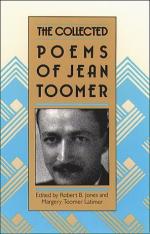|
This section contains 11,324 words (approx. 38 pages at 300 words per page) |

|
SOURCE: “‘In the Land of Cotton’: Economics and Violence in Jean Toomer's Cane,” in African American Review, Vol. 32, No. 2, Summer, 1998, pp. 181-98.
In the following essay, Foley explores Toomer's treatment of economic factors and racial violence in Cane.
Critics of Jean Toomer's Cane disagree about the text's relation to the economic and social realities confronting rural and small-town Georgia blacks in the early 1920s. Some scholars read the novel as a nostalgic celebration of a vanishing peasant existence close to the earth. If the text acknowledges the harshness of racism and poverty, it subordinates social protest to lyricism, the representation of the here and now to the search for prophetic truths beyond the limits of history. Bonnie Barthold, for example, noting that the text eschews “linear development,” argues that “the achievement of Cane” is its “mythic portrayal of a mythic truth on the verge of destruction” (159). Bowie Duncan...
|
This section contains 11,324 words (approx. 38 pages at 300 words per page) |

|


